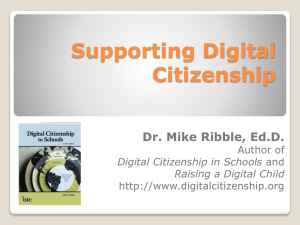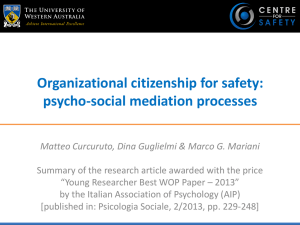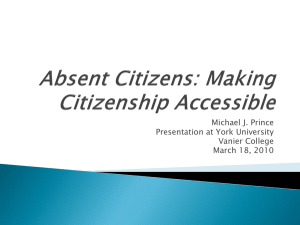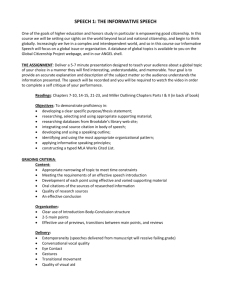organizational affective
advertisement
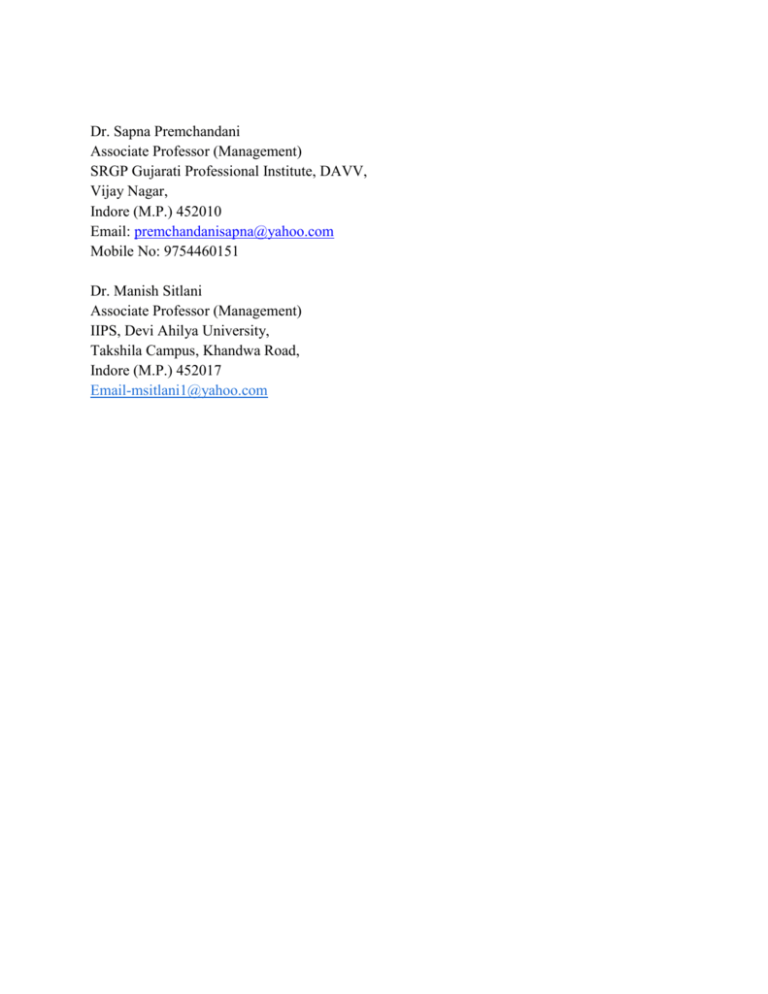
Dr. Sapna Premchandani Associate Professor (Management) SRGP Gujarati Professional Institute, DAVV, Vijay Nagar, Indore (M.P.) 452010 Email: premchandanisapna@yahoo.com Mobile No: 9754460151 Dr. Manish Sitlani Associate Professor (Management) IIPS, Devi Ahilya University, Takshila Campus, Khandwa Road, Indore (M.P.) 452017 Email-msitlani1@yahoo.com Organizational Commitment as a Predictor of Organizational Citizenship Behavior: A Study of Employees Working in Service Organizations Abstract The current study examined the relationship between organizational commitments and organizational citizenship behavior. The rationale of this paper was to study whether continuous, affective and normative organizational commitments are strong predictors of OCBO or not. The study was being conducted by collecting data from 375 employees working in different service organizations in Indore and nearby areas. Results of ‘Structural Equation Model’ (SEM) indicated that proposed structural model was found to be fit and path analysis indicated that normative commitment produced the significant effect on organizational citizenship behavior followed by affective organizational commitment where as continuous commitment produced the weakest effect on organizational citizenship behavior. Key words: Continuous commitment, affective commitment, normative commitment, OCBO, SEM etc. INTRODUCTION Employees are often considered as company’s most valuable assets; especially in service sector because total worth of an organization depends on the type of people it has. In today’s dynamic environment, to sustain a competitive advantage, companies not only have to serve quality product or service but also retain their intellectual capital which is the main source of creativity and innovation. Organizations are now becoming more conscious about the positive work behaviors and want their employees to go beyond the formal level of job description that is required to perform a job consistently (Lavelle et al, 2009). Successful organizations want employees who will perform other than their routine assigned tasks and work beyond their expectations. In recent times tasks are mainly done in teams with higher flexibility and positive attitudes. These organizations require employees who trust and help each other, stay away from avoidable conflicts and occasionally agree to task-related nuisance. This discretionary behavior is termed as organizational citizenship behavior (OCB) which is not the part of job description. Employees and organization may have different views regarding organizational commitments and organizational citizenship behaviors. If organization has good commitments to its members, than they will be more loyal to their organization. Likewise, when members work beyond their expectations; the organization will treat them well. In the field of Organizational Behavior, the major research on OCB started in 1990s and still ongoing at a steady pace. The current research is focused on studying the effects of affective, continuous and normative commitment in predicting the organizational citizenship behavior (OCB) in service sector. The reason for choosing three important dimensions of organization commitment as research variables is that they affect job behavior and ultimately organizational outcomes. Positive attitude of people helps the organization to improve its effectiveness. Further, researcher has not found the study who proposed the structural model of continuous, affective and normative commitment to predict OCBO. The current study would primarily be focused to aid in a better understanding of the OCB in service sector. Organization Commitment: Organizational Commitment is very much important. It is vital for good performance and productivity of an organization. In the last decades managers and behavioral scientists have started giving a substantial attention on the organizational commitment of employees. In the beginning the work on organizational commitment was carried out by Bcker (1960), and followed by Etzioni (1961), Buchanan (1974) and Mowday et al. (1982). These studies viewed organizational commitment as a single dimension concept. Further, Porter et al. (1974) described organizational commitment as an emotional affection to the organization, characterized by an intuition to remain in it; identification with the values and goals of the organization; and a willingness to put extra effort. Organizational commitment refers to “the relative strength of an individual’s identification with and involvement in a particular Organization (Mowday Et.al 1979)”. Strongly committed employees are more likely to continue their membership with the organization than those with weak commitment. Porter, et. al. (1974), opined that commitment has of two distinctive but related concepts, namely attitudinal and behavioral commitment. Attitudinal commitment is the extent to which an individual is trustworthy and dedicated towards its organization. It is an individual’s identification and participation in the organization In the behavioral approach, the employee is said to be committed to an organization if he/she is bound by past actions of “sunk costs” (fringe benefits, salary as a function of age and tenure). Thus, an individual becomes “committed” to an organization because it has become too costly for the employee to leave. In this approach, organizational commitment is depicted as more calculated in nature (Etzioni, 1961). Becker (1960) concentrated on what he termed the ‘side-bet theory’, which attempted to explain the process by which employees attached themselves to organizations through investments such as time, effort and rewards. In 1990, Allen and Meyer (and Meyer and Allen in 1997) introduced following three approaches: affective, continuance and normative commitment: 1. Affective Commitment (positive feelings to stay with organization): The employee’s affective or emotional connection that he feels toward to the organization. It refers to the employee’s emotional attachment to, identification with, and contribution in, the organization. 2. Continuance Commitment (cost-consciousness): The perceived costs associated with leaving the organization such as loss of associates, retirement benefit, such as pension, common and well known work atmosphere, etc. that are better than the benefits of taking a new employment in any other organization, or because there is no another employment opportunities. 3. Normative Commitment (obligation-consciousness): It refers to an employee’s feeling of obligation to remain with the organization [as employees have internalized the values and goals of the organization]. Organization Citizenship Behavior Organizational Citizenship Behavior is somewhat fresh concept considered under Organizational Behavior. Different researchers define and interpret OCB in a similar manner. Jacqueline et al. (2004) defined it as an extra-role behavior of employees which is not a formal part of their job behavior but somewhat they do happily as a result of organizational work situation. Todd, 2003 opined that OCB has an overall impact on organization effectiveness. Organ (1988) defined OCB as “individual behavior that is discretionary, not directly or unconditionally recognized by the formal reward system, and that promotes the successful functioning of the organization”. Further, (Organ, 1997) redefined it to better differentiate between OCB and task performance. He defined OCB as “task performance that supports the social and psychological environment in which it takes place”. As organizational citizenship behavior is defined as helping behavior that goes beyond the job description or task performance, it is important to understand that the difference between task performance and OCB. Borman, (2004) defined OCB as participation in events, procedures or actions that are not officially a part of the job description, but that do good to the entire organization. It is considered as one of the vital factors influencing organizational success (Organ, Podsakoff and MacKenzie 2006). Further, Borman (2004) differentiated OCB and task performance in two ways. First, the tasks or different work activities that are needed to carry out a job are distinctive to each job. Employees occupying same position might perform different tasks in different organizations. A behavior that helps in one job will likely help an organization in another job. Second, the predictors for task performance and OCB are different. An employee’s personality, loyalty and dedication will predict OCB; an employee’s personal abilities, knowledge, skills, and attitude will predict their task performance. The employees will have higher task performance only when the job assigned to them is of their interest and as per their knowledge, skills, and abilities than will those without the proper match. Originally (Bateman and Organ, 1983) organized OCB into altruism and compliance. Later, Compliance was re-named with conscientiousness. Further, sportsmanship, courtesy, and civic virtue were added by Organ in 1988. Finally, peacemaking and cheerleading were added into the list of dimensions (Organ 1990). Furthermore, altruism, cheerleading, and peacemaking were grouped into a new category named helping behavior (Organ, 1997). Final listed dimensions of OCB are: 1. Conscientiousness. Conscientiousness refers to impersonal behavior that benefits the organization as a whole. It is used to indicate that a particular individual is careful, organized, responsible and hardworking. 2. Sportsmanship. Sportsmanship is an employee’s readiness to deal with unavoidable inconvenience and poor situations without complaints or grievances, thus saving organizational energies for job completion and reducing the workloads of managers (Organ and Ryan, 1995; Organ, 1990). 3. Courtesy. Courtesy is demonstrated by preventing organization problems through communication and general consideration for others. 4. Civic Virtue. Civic virtue is participating in the life and culture of the organization; this is not considered behavior that is targeted at individuals, rather, this behavior targets the organization. 5. Helping behavior. Helping behavior includes altruism, peacekeeping, and cheerleading. Voluntarily familiarize a new employee with organization, solving conflicts among employees, and acknowledging fellow employees’ accomplishments. In addition to this, (Williams and Anderson, 1991) categorized OCB into OCBI, behavior that is directed towards the individual (i.e. courtesy and helping behavior) and OCBO, behavior that is directed towards the organization (i.e. conscientiousness, civic virtue, and sportsmanship). Further, Podsakoff, et al. (2009) conducted a research and reported that individual-level behavior is likely to be related with performance evaluation ratings and reward allotment, where as Organizational-level behavior was found to be related with employee competence, organizational return, and productivity among employees. Lee and Allen (2002) constructed a 16-item scale to measure OCBI and OCBO. The scale includes statements that describe either OCBI or OCBO behavior which is useful in determining the type of OCB that an individual is most likely to perform. Of the 16 items on the scale, eight represent OCBI behaviors and eight represent OCBO behaviors. In the current study, researchers picked eight statements that describe Organization Citizenship Behavior towards Organization (OCBO) as one of the research variables. REVIEW OF LITERATURE A comprehensive review of available literature related to exogenous and endogenous constructs/ independent and dependent variables are carefully reviewed to explore the existing state of research. From the review of relevant literature, it was found that Job-related attitudes influence subsequent organizational citizenship behavior. Dick et al. (2006) opined that citizenship seems to be discretionary behaviors of employees and the way they perceives the organization would most likely affect their attitude to either perform well or withhold such performance. OCB in general refers to behaviors that affect the organization or its members positively (Poncheri, 2006). Turnipseed and Rassuli, 2005 defined OCB as protecting the organization when it is criticized or advice peers to invest in the organization, or a behavior that exceeds routine expectations (Joireman et al. 2006). Organizational Commitment and OCB Organizational commitment and organizational citizenship behaviors are two undividable constructs and very much related to employee and organizational performance. Several researches, (O’Reilly and Chatman, 1986; Organ and Ryan, 1995; Williams, Pitre and Zanuba, 2002) emphasized on organizational commitment and organizational citizenship behaviors at improving employee performance. (Rehan and Islam, 2013) have found organizational commitment as an important antecedent of organizational citizenship behaviors. Further, they opined that organizational commitment precedes organizational citizenship behaviors because employee loyalty and identification with the organization result positive employee behaviors. LePine, Erez and Johnson (2002) and linked organizational commitment with increased organizational citizenship behavior OCB can be affected by instilling in employees a perception of expertise in their job tasks (Todd, 2003). Organizational commitment has been conceptualized as composed of affective, continuance, and normative commitments (Meyer and Allen 1984; Allen and Meyer 1990). Employees tend to accomplish more for their organizations in a positive manner when they have a strong emotional attachment to their organizations; therefore, their high affective organizational commitment is expected to have a positive effect on their work behaviors, including OCB. (Meyer et al.1989). Organizational citizenship behavior (OCB) is anything constructive and productive those employees do, on their own wish, which supports co-workers and benefits the organization. In general, employees who commonly show positive OCB may not always be the top performers, but they are the ones who are known to ‘go the extra mile’ or ‘go above and beyond’ the minimum efforts required to do a merely satisfactory job. Murali Kumarn. C et al. (2013) reported a significant relationship between citizenship behavior and organizational commitment. OCBs yield significantly higher outcomes in the long term than in the short term for the organization (Joireman et al. 2006). Social exchange theory specifies that an employee engages in OCB because the organization has given them a good job and treats them equitably and fairly. This positive treatment compelled these employees to give back to the organization that has given them so much. The employees feel that they owe the organization and they attempt to pay back the organization through performing OCB. Organizational concern is comprised of two elements. First, the individual wants to help the organization because he or she associates with it. Second, the individual believes that by impacting the organization in a positive manner he or she is also impacting the individuals within the organization (Halbesleben et al., 2010). Additionally, Rioux and Penner’s (2001), indicated that organizational concern is more associated with OCBO than OCBI Zoe, S. D. (2007); found organizational commitments as predictor of organizational citizenship behaviors. David et al (2008) focusing on the organizational commitment and found that it has an impact on the organizational citizenship behavior. In one study, a meta-analysis has shown that OCB correlated with organizational commitment (Jen, 2004). In the other research, Aaron (2004) reported that organizational commitment was positively related to OCB. OBJECTIVES OF THE STUDY The main objectives of the current study is To explore the effect of various dimensions of Organization Commitment on OCBO in service sector. To propose and validate a structural model for studying the effects of various dimensions of organization commitment on OCBO in service sector. The sub-objectives are i. ii. iii. To explore the effect of continuous commitment on OCBO in service organizations. To explore the effect of affective commitment on OCBO in service organizations. To explore the effect of normative commitment on OCBO in service organizations. METHODS AND PROCEDURES Sample The study was carried on 375 executives working in service industry in Indore and nearby geographical areas, who were selected on convenient basis. The broad industries included within were various banks, hospitals, big departmental stores, hospitality etc. Of the total number of participants 66% were male and 34% were female with the age ranged from 25 to 56 years and above and 47.2% had work experience of 1-10 years, 29.1% had 11-20 years’ experience, 20.5% had 21-30 years, and 3.2% had above 31 years of work experience. Further, 21.6% were traditional graduate, 24.5% traditional post graduate, 19.5% professional graduate, 34.4% professional post graduate. Tools for data collection The instrument used in this study was a questionnaire developed on the basis of standard measures taken from the relevant literature, validated across a large number of earlier studies. It composed of 3 parts. The first part of the questionnaire deals with the questions related to the demographic attributes of the employees. The second part contains a 19-item scale to determine the level of organizational commitment. It is the enhanced scale proposed by Stephen Jaros (2007), which is originally based on Meyer and Allen’s (1997) three-component model for the measurement of organizational commitment. Affective commitment: This index is used as a measure of employee affection with the organization and is composed of seven items. Continuous commitment: This index measures employee’ perceived costs associated with leaving the organization and is composed of six items. Normative commitment: This index measures employee’s feeling of obligation to remain with the organization and is composed of six items. Finally, in the third part, Lee and Allen’s (2002) scale that measures OCBO and OCBI was used to measure the type of OCB intention. Of the 16 items on the scale, researcher picked eight items of OCBO to carry out the study. All the items (27) were intermixed in the questionnaire in order to avoid the same answer pattern and are required to be completely filled. Participants were asked to evaluate themselves on each of the item with response possibilities ranging from 1= strongly disagree to 5= strongly agree. DATA ANALYSIS The data analysis was conducted with the help of SPSS 21.0 and SPSS Amos 21.0. On the basis of variables and dimensions identified through available literature, Confirmatory Factor Analysis was conducted to estimate and validate the measurement model. Thereafter, structural relationships were proposed and related hypotheses relationship between independent and dependent variables were tested through Structured Equation Modeling (SEM). CONFIRMATORY FACTOR ANALYSIS Confirmatory Factor Analysis (CFA), a technique used to estimate measurement model which is the very first step in Structural Equation Model (SEM). The main purpose of this estimation is to specify the loading of each observed item (indicator) on a particular dimension (construct) and to assure reliability and validity of measures and constructs. It has been discussed below: CONSTRUCTS OF THE MEASUREMENT MODEL The current study was undertaken on the basis of four constructs represented by 27 measured parameters, which were identified from the available literature. These have been shown in the following table-1, followed by proposed measurement model: Refer Table-1 PROPOSED MEASUREMENT MODEL Refer Fig-1 GOODNESS OF FIT OF MEASUREMENT MODEL Goodness of Fit means how well the specified model reproduces the covariance matrix among the indicator items (Malhotra and dash, 2011). A four-factor measurement model was set up, and a confirmatory factor analysis (CFA) was conducted to test the measurement model. The Goodness of Fit of model was evaluated on different absolute fit indices such as goodness-of-fit-index (GFI) and adjusted goodness-of-fit index (AGFI). Higher values are desirable, where as error or deviation was assessed by badness 2 of-fit, such as chi-square (X ), root mean square residual (RMSR), and the root mean square residual error of approximation (RMSEA) so lower values of these indices are desirable. The related values have been exhibited in table 2 below: Refer Table-2 It can be seen from the table-2 that, all the fit indices collectively indicate that overall fit of the measurement model is within the acceptable ranges. Reliability and Validity of the Measurement Model After assessing the fitness of measurement model-data, its reliability and validity were assessed, which have been discussed below: A standardized factor loading (SFLs) was used to test item reliability and composite reliability was used to test construct reliability. Further, convergent validity was assessed by average variance extracted (AVE). AVE is the variance in the indicators or observed variables that is explained by the latent construct. Discriminant validity is achieved if the square root of the AVE is larger than the correlation coefficients. In the current study, researcher dropped the item OCBO-16 because of the negative factor loading. All the related values have been exhibited in table 3 below: Refer Table-3 As seen from table-3 above , Composite Reliability (CR) values for various measures such as continuous commitment, affective commitment, OCBO and normative commitment were found to be highly satisfactory 0.946, 0.958, 0.941, and 0.956 respectively, which exceeded the recommended cutoff value of 0.7; and is reasonable enough to conclude that the scales are reliable. AVE values were found to be greater than 0.7 and each item loading was greater than 0.70, which provides empirical support for the convergent validity. Discriminant validity is achieved if the square root of AVE is larger than the correlation coefficients. Results of confirmatory factor analysis (CFA) indicted that proposed measurement model was said to be appropriate because of good model fitness and accepted values of reliability and validity parameters. SEM ANALYSIS Conducting Path Analysis to Test Hypothesized Casual Relationship After confirming the various dimensions and related variables of measurement model, a structural model was proposed to test the hypothesized relationship between the constructs. Finally, 26 measured variables with four constructs were taken together to develop structural model. Organizational citizenship behavior toward organization (OCBO) is being taken as endogenous (dependent) variable, whereas three dimensions i.e. Continuance Commitment (a), Affective Commitment (b), and Normative Commitment (d) were taken as exogenous (independent) variables. Following hypotheses were proposed to test the hypothesized relationships: H1 Continuous commitment will have direct and significant effect on OCBO in service organization. H2 Affective commitment will have direct and significant effect on OCBO in service organization. H3 Normative commitment will have direct and significant effect on OCBO in service organization. The proposed structural model has been exhibited in figure 2 below: Proposed Structural Model Refer Fig-2 Assessment of Proposed Structural Model Refer table-4 It can be seen from table-4 that proposed structural model was found to fit the data satisfactorily as the fit values were well within the acceptable ranges [X2=1762.885, p < 0.001, CFI=0.836, NFI= 0.898, RMR=0.071]. As with the NFI, values for this statistic range between 0 and 1.0 with values closer to 1.0 indicating good fit. Though, experts like Malhotra, and Dash, (2011); Hu and Bentler (1999), recommended the value of NFI, CFI and various other fit indices as 0.9 but some recommendations as low as 0.80 and above as a cutoff have also been preferred. Collectively, these fit indices indicated that the structural model is acceptable. HYPOTHESIS TESTING The proposed hypothesized relationships were tested using path analysis, and the result of the same has been exhibited below: Refer Table-5 As seen from the table above, the effect of continuous commitment on OCBO is in hypothesized direction and was statistically significant at 0.001 with standardized path coefficient (β) value 0.12, thus research hypothesis, H1 namely continuous commitment will have direct and significant effect on OCBO in service organization is partially supported. In H2, it was hypothesized that the affective commitment will have direct and significant effect on OCBO in service organization. Table-5, (fig-2) showed that the effect of affective commitment on OCBO is in hypothesized direction and was statistically significant at 0.001 with standardized path coefficient (β) value 0.32, thus researcher accepted that affective commitment produced the positive influence over OCBO. H3 predicted that normative commitment will have direct and significant effect on OCBO in service organization. As indicated in table-5, (fig-2) that the effect of normative commitment on OCBO is in hypothesized direction and was statistically significant at 0.001 with standardized path coefficient (β) value 0.94. This result strongly supported researcher’s belief that normative commitment positively influences OCBO. As all the hypothesized relationships were found significant, the proposed structured model appeared to be the final structural model relating the dependent and independent constructs. DISCUSSION Organizational citizenship behavior (OCB) is the term used to explain employees’ constructive approach towards job roles and the organization. Organizational commitment and organizational citizenship behaviors are considered as two indivisible constructs and very much linked to employee and organizational performance. Several researchers including O’Reilly and Chatman, (1986); Organ and Ryan, (1995) and Williams, Pitre and Zanuba, (2002) have emphasized on organizational commitment and organizational citizenship behaviors to improve employee performance. In line with his, the current research studied the effects of organizational commitments on OCBO. First, the study result indicated that the structural model for continuous, affective and normative commitment and OCBO was confirmed. Second, findings of path analysis indicated that normative commitment produced the significant effect on organizational citizenship behavior followed by affective organizational commitment where as continuous commitment produced the weakest effect on organizational citizenship behavior. This finding of current study was consistent with the findings of Kilic (2013), which revealed a positive relationship between affective commitment and organizational citizenship behaviors but a positive and weak relationship between continuance commitment and organizational citizenship behaviors. Finally, findings of the study revealed that affective and normative commitments can strongly predict OCBO than continuous commitment. CONCLUSION Organizational citizenship behavior is considered as an important key for organizational competitiveness, productivity and endurance in the fast changing global market. Murphy, Athanasau and Neville (2002), opined that success, growth, efficiency and achievements, of any organization depend on the behaviors of its employees. In order get these desirable behaviors, various researchers have found organizational commitments as important antecedents’ to organizational citizenship behaviors, Alizadeh et al (2012). Current study concluded that highly affectionate employees are more loyal, perceive themselves as a member of the organization and inculcate organizational values into their behaviors. They feel obligation to continue their membership with no or less intention to quit the organization. Finally, it is interpreted that affective and normative commitments can be strong predictors of OCBO; whereas continuous commitment is perceived to be a week predictor. IMPLICATIONS AND RECOMMENDATIONS Findings from this study have important and practical implications. The study has revealed that organization commitment was strongly correlated with organizational citizenship behavior towards organization. This becomes an important implication for organizations because if employees are highly committed and loyal, than organizations should reciprocate their loyalty in a positive way by treating them well. It is recommended that organizations should follow such practices that are instrumental in inculcating commitment and loyalty in employees One of the prior studies, Alizadeh et al (2012) opined organization commitment as one of the important antecedents of OCB. It may mean that continuous, affective and normative commitments can increase the occurrence of positive behaviors (OCBO). It is advisable that management should match individual as well as organizational interests to develop the positive attitude among employees. As the current study concluded organization commitments as predictors of organizational citizenship behavior towards organization (OCBO). This implies that successful organizations require employees who continuously show positive attitude and good job behaviors. So, organizations should create the positive work environment, giving employees the platform of growth and development to enhance their citizenship behavior. LIMITATIONS AND SCOPE FOR FUTURE RESEARCH The current study has certain limitations attached with it. First, the size of sample (375) studied is not considered as large enough to generalize the findings of the study. A larger sample would be more appropriate which may facilitate in validating the findings. Second, the sample has been chosen from different service organizations in Indore and nearby areas, and so it still needs to be explored whether the findings of this study can be replicated in different sectors and geographical area for further verification and generalization. Third, current study is undertaken with the standardized measures taken from the available literature, future research could be done by developing and validating the new measures for the variables in the study. REFERENCES Aaron, C. and Yardena, K. (2004), "Professionalism and organizational citizenship behavior: An empirical examination among Israeli nurses," Journal of Managerial Psychology, vol. 19, pp. 386-405. Alizadeh, Z., Darvishi, S., Nazari, K. and Emami, M. (2012). “Antecedents and consequences of organizational citizenship behavior (OCB)”. Interdisciplinary Journal of Contemporary Research in Business, 3 (9), 494-505. Allen, N.J. and Meyer, J.P. (1990). The measurement and antecedents of affective, continuance and normative commitment to the organization. Jounal of Occupational Psychology, 63(1), 1-18. Allen, N.J. and Meyer, J.P. (1996). Affective, continuance, and normative commitment to the organization: An examination of construct validity. Journal of Vocational Behavior, 49, 252 276. Bateman, T. S., and Organ, D. W. (1983.). Job satisfaction and the good soldier: The relationship between affect and "citizenship." Academy of Management Journal, 26, 587-595. Doi: 10.2307/255908 Becker, H. (1960). Notes on the concept of commitment. American Journal of Sociology, 66, 32 – 42. Borman, W.C. (2004). The concept of organizational citizenship. Current Directions in Psychological Science, 13, 238-241. Doi: 10.1037/0021-9010.91.1.70 Buchanan, B. (1974). Building organization commitment: The socialization of managers in work organizations. Administrative Science Quarterly, 22, 533–546. David, A. F., and Thomas, L. T. (2008) "Job satisfaction and organizational citizenship behavior (OCB): does team commitment make a difference in self-directed teams?," Management Decision, vol. 46, pp. 933-947, Dick, R.,Grojean, M., Christ, O., and Wieseke, J. (2006). Identity and the Extra Mile: Relationships between Organizational Identification and Organizational Citizenship Behaviour. British Journal of Management, Vol. 17, pp.283–301. Etzioni, A. (1961). A comparative analysis of complex organisations. New York:Free Press. Halbesleben, J.R.B, Bowler, W.M., Bolino, M.C., and Turnley, W.H. (2010). Organizational concern, prosocial values, or impression management? How supervisors attribute motives to organizational citizenship behavior. Journal of Applied Social Psychology, 40, 1450-1489. Doi: 10.1111/j.1559-1816.2010.00625.x Hu, L.T. and Bentler, P.M. (1999), "Cutoff Criteria for Fit Indexes in Covariance Structure Analysis: Conventional Criteria versus New Alternatives," Structural Equation Modeling, 6 (1), 1-55. Jacqueline, A-M.,Shapiro, C., Kessler, I., and Purcell, J. (2004). Exploring Organizationally Directed Citizenship Behaviour: Reciprocity or ‘It’s my job’? Journal of Management Studies, Vol. 41, pp. 1. Jen, H. H. Bih; H. J. and Chyan, Y. (2004) "Satisfaction with business-to-employee benefits systems and organizational citizenship behavior: An examination of gender differences," International Journal of Manpower, vol. 25, pp. 195-210. Joireman, J.,Daniels, D., Falvy, J., and Kamdar, D. (2006). Organizational Citizenship Behavior as Function Of Empathy Consideration of Future Consequences, And Employee Time Horizon: An Initial Exploration Using An In-Basket Simulation of OCBs. Journal of Applied Social Psychology, Vol. 36, No. 9, pp. 2266–2292. Kashif, M., Khan, Y., and Rafi, M. (2011). An Exploration of the determinants of OCB in the telecommunication sector of Pakistan. Asian Journal of Business Management, 3(2), 91-97. Kilic, E. (2013). The relationship among organizational commitment and organizational citizenship behavior: A research study on call center employees."IS, GUC" Industrial Relations and Human Resources Journal, 15 (3), 83-93. Lavelleet al, (2009). Commitment, procedural fairness, and organizational citizenship behavior: a multi focianalysis” Journal of Organizational Behavior, 30: 337–357 doi: 10.1002/job.518. Lee, K., and Allen, N.J. (2002). Organizational citizenship behavior and workplace deviance: the role of affect and cognition. Journal of Applied Psychology, 87, 131-142. Doi: 10.1037//00219010.87.1.131 Lee, K., and Allen, N.J. (2002). Organizational citizenship behavior and workplace deviance: the role of affect and cognition. Journal of Applied Psychology, 87, 131-142. Doi: 10.1037//0021 9010.87.1.131 LePine, J.A., Erez, A. and Johnson, D. E. (2002). The nature and dimensionality of organizational citizenship behaviour: A critical review and meta-analysis. Journal of Applied Psychology, 87, 52-5. Malhotra, N., K. and Dash, S., (2011). Marketing Research: An applied Orientation, sixth edition, Meyer, J.P., and Allen, N.J. (1984). Testing the ‘side-bet theory’ of organizational commitment: some methodological considerations, Journal of Applied Psychology, 69(3), 372-378. Meyer, J.P., and Allen, N.J. (1997). Commitment in the workplace: Theory, research and application. Thousand Oaks: Sage. Meyer, J.P., Paunonen, S.V., Gellatly, I.R., Goffin, R.D., and Jackson, D.N. (1989). Organizational commitment and job performance: it’s nature of the commitment that counts, Journal of Applied Psychology, 74(1), 152-156. Mowday, R.T., Porter, L.W., and Steers, R.M. (1982). Employee-organization linkages: The psychology of commitment, absenteeism and turnover. San Diego,CA: Academic Press. Mowday, R.T., Steers, R.M.,and Porter, L.W. (1979). The measurement of organizational commitment. Journal of Vocational Behavior, 14: 224 –247. Murali Kumaran, C., and Sivasubramanian, M. (2013). A Study on Organizational Citizenship Behavior and Organizational Commitment among Employees. International Journal of Management Volume 4, Issue 4, 103-110 Murphy, G., Athanasau, J., and Neville, K. (2002). Job satisfaction and organizational citizenship behavior. Journal of Managerial Psychology, 17, 287-297. O’Reilly, C., and Chatman, J. (1986). Organizational commitment and psychological attachment: the effects of compliance, identification, and internalization on pro-social behaviour. Journal of Applid Psychology, 7, 492-499. Organ D, Podsakoff P, MacKenzie S (2006). Organizational citizenship behavior: its nature, antecedents, and consequences. Thousand Oaks: CA: Sage Publications. p. 34. Organ, D. W. (1988). Organizational citizenship behavior: the good soldier syndrome. (pp. 143). Lexington: Lexington Books. Organ, D. W. (1990), “The Motivational Basis of Organizational Citizenship Behavior”, in B. M. Staw and L. L. Cumming (Eds), Research in Organizational Behavior, 12: 43-72, Greenwich, CT: JAI Press. Organ, D. W. (1997). Organizational citizenship behavior: it's construct clean-up time. Human Performance, 10, 85-97. Doi: 10.1207/s15327043hup1002_2 Organ, D. W. and K. Ryan (1995), “A Meta-Analytic Review of Additional and Dispositional Predictors of Organizational Behavior”, Personal Psychology, 48: 775-802. Podsakoff, N.P., Whiting, S.W., Podsakoff, P.M., and Blume, B.D. (2009). Individual- and organizational-level consequences of organizational citizenship behaviors: A meta-analysis. Journal of Applied Psychology, 94, 122-141. Doi: 10.1037/a0013079 Poncheri, R. (2006). The Impact of Work Context on the Prediction of Job Performance. North Carolina State University. Porter, L. W., Steers, R. M., Mowday, R. T., and Boulian, P. V. (1974). Organizational commitment, job satisfaction, and turnover among psychiatric technicians. Journal of Applied Psychology, 59, 603–609. Rehan, M.F., and Islam, T. (2013). Relationship between organizational commitment and citizenship behaviours. World'Journal'of'Management'and'Behavioral'Studies, 1 (1), 24<32. Rioux, S. M., and Penner, L. A. (2001). The causes of organizational citizenship behavior: a motivational analysis. Journal of Applied Psychology, 86, 1306-1314. Doi: 10.1037//00219010.86.6.1306 Stephen Jaros (2007). The Icfai 8 Journal of Organizational Behavior, Vol. VI, No. 4. Todd, S. (2003) A Causal Model Depicting the Influence of Selected Task and Employee Variables on Organizational Citizenship Behavior. Turnipseed, D., and Rassuli, A. (2005). Performance Perceptions of Organizational Citizenship Behaviours at Work: A Bi-Level Study Among Managers And Employees. British Journal of Management, Vol. 16, pp. 231–244. Werner, J. M. (1994). Dimensions that make a difference: Examining the impact of in-role and extra-role behaviors on supervisory ratings. Journal of Applied Psychology, 79: 98–107. Williams L, Anderson S (1991).Job Satisfaction and Organizational Commitment as Predictors of Organizational Citizenship and In-Role Behaviors. J. Manage., 17:601-617 Williams, S., Pitre, R., and Zanuba, M. (2002). Justice and organizational citizenship behavior intentions: Fair rewards versus fair treatment. The journal of social psychology, 142 (1), 33-44. Yilmaz, K., and Bokeoglu, O.C. (2008). Organizational citizenship and organizational commitment in Turkish primary schools. World Applied Sciences Journal, 3, 775-780. Zoe, S. D. (2007) "The influence of service climate and job involvement on customer-oriented organizational citizenship behavior in Greek service organizations: a survey," Employee Relations, vol. 29, pp. 469-491. Table-1 CONSTRUCTS WITH THEIR ABBREVIATION AND NUMBER OF MEASURED VARIABLES IN MEASUREMENT MODEL Constructs Abbreviation Continuous Commitment CC Affective Commitment AC Organization Citizenship Behavior towards Organization. OCBO Normative Commitment NC a b c No of measured variables 6 7 8 d Total 6 27 Table-2 GOODNESS OF FIT INDICES OF PROPOSED MEASUREMENT MODEL Absolute fit indices Model fit index goodness-of-fit-index (GFI) adjusted goodness-of-fit-index (AGFI) chi-square (X2) chi-square (X2)/df root mean square residual (RMSR) root mean square residual error of approximation (RMSEA) Recommended value >0.90 >0.80 P</=0.05 <3.0 <0.09 <0.08 Value for measurement model 0.875 0.852 .000 3.343 0.005 0.064 Table-3 RELIABILITY AND VALIDITY ASSESSMENT OF THE MEASUREMENT MODEL CFA Results of the Indicator Variables in Measurement Model Construct Continuous commitment Affective commitment Scale Items Std. Factor Loading (SRW) Error CC1 0.87 0.25 CC2 CC3 CC4 CC5 CC6 AF7 AF8 AF9 AF10 AF11 AF12 0.80 0.61 0.86 0.83 0.83 0.76 0.86 0.82 0.87 0.85 0.84 0.23 0.20 0.15 0.26 0.20 0.14 0.20 0.17 0.22 0.24 0.24 Composite Reliability (CR) >.7 Average Variance Extracted (AVE) Convergent validity, >.5 Square Root of AVE 0.946 0.75 0.87 0.958 0.77 0.88 OCBO Normative commitment AF13 OCBO14 OCBO15 OCBO16 OCBO17 OCBO18 OCBO19 OCBO20 OCBO21 NC22 NC23 NC24 NC25 NC26 NC27 0.64 0.90 0.90 -0.22 0.82 0.88 0.82 0.77 0.76 0.89 0.87 0.80 0.75 0.83 0.77 0.18 0.26 0.24 0.19 0.21 0.27 0.19 0.19 0.18 0.29 0.26 0.29 0.24 0.23 0.18 0.956 0.72 0.85 0.941 0.76 0.87 Table-4 GOODNESS-OF-FIT STATISTICS (STRUCTURAL MODEL) Incremental fit indices Model fit index Normed fit index (NFI) Comparative fit-index (CFI) chi-square (X2) root mean square residual (RMSR) Recommended value >0.90 >0.80 P</=0.05 <0.09 Value for measurement model 0.898 0.836 .001 0.071 Table-5 RESULTS OF HYPOTHESIS TESTING Path Analysis Results Hypothesis Path Relationship Std. Path Coefficient Significance p Support H1 a→c CC→OCBO 0.12 *** √ H2 b→c AC→OCBO 0.32 *** √ H3 d→c NC→OCBO 0.94 *** √ ***p<0.001 Fig. 1 PROPOSED MEASUREMENT MODEL FIG-2: PROPOSED STRUCTURAL MODEL Abbreviations Exogenous Variables a- Continuous commitment (CC) b- Affective commitment (AC) d- Normative commitment (NC) Endogenous Variable c- Organizational Citizenship Behavior toward Organization (OCBO)


